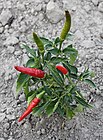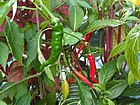Note: This is a project under development. The articles on this wiki are just being initiated and broadly incomplete. You can Help creating new pages.
Difference between revisions of "Capsicum - Pepper"
Adityareview (talk | contribs) (→Where to get the saplings) |
|||
| (34 intermediate revisions by 4 users not shown) | |||
| Line 1: | Line 1: | ||
| − | [[File:800px-Pepper%2C_കുരുമുളക്.JPG|thumb| | + | [[File:800px-Pepper%2C_കുരുമുളക്.JPG|thumb|right]] |
| − | [[ | + | '''Capsicum''' is a genus of flowering plants in the nightshade family Solanaceae. Its species are native to the America. It is used as spices and food vegetables. |
| + | ==Uses== | ||
| + | {{Uses|Cancer}}, {{Uses|Indigetion}}, {{Uses|Cold}}, {{Uses|Cough}}, {{Uses|Viral infection}}, {{Uses|Flu}}, {{Uses|Pimples}}, {{Uses|Depression}}. | ||
| + | |||
| + | ==Parts Used== | ||
| + | {{Parts Used|Fruits}}, {{Parts Used|Leaves}}. | ||
| + | |||
| + | ==Chemical Composition== | ||
| + | Calcium, Iron, Magnesium, Phosphorus, Potassium, Rutin, Selenium, Sodium, Sulphur, Vitamins A, B-complex, Vitamin C<ref name="chemical composition"/> | ||
| + | |||
| + | ==Common names== | ||
| + | {{Common names|kn=|ml=|sa=|ta=|te=|hi=Shimla mirch|en=Capsicum, Sweet Pepper}} | ||
| + | |||
| + | ==Properties== | ||
| + | Reference: Dravya - Substance, Rasa - Taste, Guna - Qualities, Veerya - Potency, Vipaka - Post-digesion effect, Karma - Pharmacological activity, Prabhava - Therepeutics. | ||
| + | ===Dravya=== | ||
| + | |||
| + | ===Rasa=== | ||
| + | |||
| + | ===Guna=== | ||
| + | |||
| + | ===Veerya=== | ||
| + | |||
| + | ===Vipaka=== | ||
| + | |||
| + | ===Karma=== | ||
| + | |||
| + | ===Prabhava=== | ||
| + | |||
| + | |||
| + | ==Habit== | ||
| + | {{Habit|Herb}} | ||
| + | |||
| + | ==Identification== | ||
| + | ===Leaf=== | ||
| + | {{Leaf|Simple|Lternate|Elliptical to lanceolate, with smooth margins (entire)}}<ref name="Leaf"/> | ||
| + | |||
| + | ===Flower=== | ||
| + | {{Flower|Unisexual|Around 1.5 cm, or 1 in, in diameter|White|5|Flowers are borne singly or, rarely, in pairs in the axils (where leaves join stems)}} | ||
| + | |||
| + | ===Fruit=== | ||
| + | {{Fruit|Vary|Vary|Yellow, orange, red, or purple|The fruits are many-seeded berries--pod-like|Many}} | ||
| + | |||
| + | ===Other features=== | ||
| + | |||
| + | ==List of Ayurvedic medicine in which the herb is used== | ||
| + | * [[Vishatinduka Taila]] as ''root juice extract'' | ||
| + | |||
| + | ==Where to get the saplings== | ||
| + | You can easily purchase seeds from online stores such as Amazon or Flipkart, etc. For young seedlings, you can purchase them from the nearest plant nursery. | ||
| + | |||
| + | ==Mode of Propagation== | ||
| + | {{Propagation|Seeds}}. | ||
| + | |||
| + | ==How to plant/cultivate== | ||
| + | Bell peppers are warm-season crops and grow best at temperatures between 18 and 30°C (65–86°F)<ref name="How to plant/cultivate"/> | ||
| + | |||
| + | ==Commonly seen growing in areas== | ||
| + | {{Commonly seen|Temperate area}}, {{Commonly seen|Meadows}}. | ||
| + | |||
| + | ==Photo Gallery== | ||
| + | <gallery class="left" caption="" widths="140px" heights="140px"> | ||
| + | Capsicum annuum 10 - Kew.jpg|Leaves | ||
| + | Capsicum annuum 11 - Kew.jpg|At feild | ||
| + | Capsicum annuum 2015 G1.jpg|Whole herb | ||
| + | Capsicum annuum 20150910.jpg|Flower | ||
| + | Capsicum annuum 6 - Kew.jpg|Nuts | ||
| + | Capsicum annuum 9 - Kew.jpg|Fruits | ||
| + | </gallery> | ||
| − | + | ==References== | |
| + | <references> | ||
| + | <ref name="chemical composition">[https://www.mdidea.com/products/new/new00504.html Phytochemicals and Constituents of Capsicum]</ref> | ||
| + | <ref name="How to plant/cultivate">[https://plantvillage.psu.edu/topics/pepper-bell/infos Practical palnts]</ref> | ||
| + | <ref name="Leaf">[http://eol.org/pages/581098/hierarchy_entries/58895517/overview Capsicum overview]</ref> | ||
| + | </references> | ||
| − | + | ==External Links== | |
| + | * [https://www.britannica.com/plant/pepper-plant-Capsicum-genus Capsicum by The Editors of Encyclopaedia Britannica] | ||
| + | * [https://www.greenmylife.in/guide-growing-capsicum/ GUIDE ON GROWING CAPSICUM] | ||
| + | * [http://eol.org/pages/581098/details Capsicum on encyclopedea of life] | ||
| + | * [https://agriculturereview.com/2020/05/how-to-grow-capsicum.html/HOW TO GROW CAPSICUM GUIDE] | ||
| − | + | [[Category:Herbs]] | |
| − | + | [[Category:Solanaceae]] | |
| − | |||
| − | |||
| − | |||
| − | |||
Latest revision as of 23:57, 16 December 2020
Capsicum is a genus of flowering plants in the nightshade family Solanaceae. Its species are native to the America. It is used as spices and food vegetables.
Contents
- 1 Uses
- 2 Parts Used
- 3 Chemical Composition
- 4 Common names
- 5 Properties
- 6 Habit
- 7 Identification
- 8 List of Ayurvedic medicine in which the herb is used
- 9 Where to get the saplings
- 10 Mode of Propagation
- 11 How to plant/cultivate
- 12 Commonly seen growing in areas
- 13 Photo Gallery
- 14 References
- 15 External Links
Uses
Cancer, Indigetion, Cold, Cough, Viral infection, Flu, Pimples, Depression.
Parts Used
Chemical Composition
Calcium, Iron, Magnesium, Phosphorus, Potassium, Rutin, Selenium, Sodium, Sulphur, Vitamins A, B-complex, Vitamin C[1]
Common names
| Language | Common name |
|---|---|
| Kannada | |
| Hindi | Shimla mirch |
| Malayalam | |
| Tamil | |
| Telugu | |
| Marathi | NA |
| Gujarathi | NA |
| Punjabi | NA |
| Kashmiri | NA |
| Sanskrit | |
| English | Capsicum, Sweet Pepper |
Properties
Reference: Dravya - Substance, Rasa - Taste, Guna - Qualities, Veerya - Potency, Vipaka - Post-digesion effect, Karma - Pharmacological activity, Prabhava - Therepeutics.
Dravya
Rasa
Guna
Veerya
Vipaka
Karma
Prabhava
Habit
Identification
Leaf
| Kind | Shape | Feature |
|---|---|---|
| Simple | Lternate | Elliptical to lanceolate, with smooth margins (entire) |
Flower
| Type | Size | Color and composition | Stamen | More information |
|---|---|---|---|---|
| Unisexual | Around 1.5 cm, or 1 in, in diameter | White | 5 | Flowers are borne singly or, rarely, in pairs in the axils (where leaves join stems) |
Fruit
| Type | Size | Mass | Appearance | Seeds | More information |
|---|---|---|---|---|---|
| Vary | Vary | Yellow, orange, red, or purple | The fruits are many-seeded berries--pod-like | Many | {{{6}}} |
Other features
List of Ayurvedic medicine in which the herb is used
- Vishatinduka Taila as root juice extract
Where to get the saplings
You can easily purchase seeds from online stores such as Amazon or Flipkart, etc. For young seedlings, you can purchase them from the nearest plant nursery.
Mode of Propagation
How to plant/cultivate
Bell peppers are warm-season crops and grow best at temperatures between 18 and 30°C (65–86°F)[3]
Commonly seen growing in areas
Photo Gallery
References
External Links
- Ayurvedic Herbs known to be helpful to treat Cancer
- Ayurvedic Herbs known to be helpful to treat Indigetion
- Ayurvedic Herbs known to be helpful to treat Cold
- Ayurvedic Herbs known to be helpful to treat Cough
- Ayurvedic Herbs known to be helpful to treat Viral infection
- Ayurvedic Herbs known to be helpful to treat Flu
- Ayurvedic Herbs known to be helpful to treat Pimples
- Ayurvedic Herbs known to be helpful to treat Depression
- Herbs with Fruits used in medicine
- Herbs with Leaves used in medicine
- Herbs with common name in Hindi
- Herbs with common name in English
- Habit - Herb
- Index of Plants which can be propagated by Seeds
- Herbs that are commonly seen in the region of Temperate area
- Herbs that are commonly seen in the region of Meadows
- Herbs
- Solanaceae






